Introduction
The Sony Cyber-shot DSC-HX300 is a new super-zoom camera that features a 50x, 24-1200mm zoom lens, 20.4 megapixel back-illuminated Exmor R CMOS sensor, 1920x1080 50p Full HD video recording with stereo sound and HDMI output, and Sweep Panoramas and 3D Still Images. Other key features of the Sony HX300 include high-speed autofocusing, a tilting 3-inch LCD screen with 921,000-dots, 10fps burst shooting mode at full resolution, ISO range of 100-12,800, enhanced Optical SteadyShot with 3-way Active Mode, Intelligent Auto Plus, Superior Auto, Program and full Manual shooting modes, a range of Picture Effects and and support for both Memory Stick PRO Duo and Secure Digital cards. The Sony Cyber-shot DSC-HX300 is available in black for £419.00 / $449.99.
Ease of Use
Sony's new Cyber-shot DSC-HX300 is virtually identical to the HX200 model that it replaces, so a lot of the comments that we made in our review of that camera apply equally to the new HX300. The HX300 clearly takes its design cues from an entry-level DSLR camera. It's one to be worn about the neck, slung over a shoulder - with the strap provided for both purposes - or tucked in a suitable camera bag. The HX300's optical zoom is now a massive 50x, up from the 30x zoom of its forebear, and the effective resolution has been boosted from 18.2 million to 20.4 million pixels from a 1/2.3-inch Sony Exmor R CMOS sensor.
The HX300 has a very chunky handgrip that's large enough to squeeze three fingers comfortably around, helping to provide a steadier hold when shooting towards the extreme telephoto end of the zoom. To further help prevent blurred shots in such circumstances and in low light, Sony has also provided optical 'SteadyShot' image stabilization, now further improved thanks to a second group of lens elements that shift rapidly to correct for tiny hand tremors, reducing the shake apparent on the LCD screen and making it easier to frame the shot.
The build and finish of the Sony Cyber-shot DSC-HX300 is of high quality, with the all-black matt finish to the body and various DSLR-like dials and controls - not to mention both angle-adjustable LCD and built-in electronic viewfinder - on initial inspection lending it an impression of being a 'serious' enthusiasts' model. The compact size also means that locating the right control is never a stretch for forefinger or thumb. Most of the features you want to access are literally at your fingertip, which of course makes for speedier overall operation. Overall dimensions are 129.6x93.2x1.03.2mm and the HX300 weighs a starter DSLR-like 623g, making it both bigger and heavier than it predecessor and most of the super-zoom competition.
The front of the Sony Cyber-shot DSC-HX300 is dominated by the Carl Zeiss Vario-Sonnar lens, here boasting a maximum aperture of f/2.8 at the widest-angle setting and a focal range the equivalent of a ultra-wide-angle 24mm to 1200mm in 35mm film terms - suggesting serious 'poke' at the telephoto end and real suitability for those paparazzi style candid portraits at full zoom, as well as of course landscapes and group portraits at the wider end.
 | 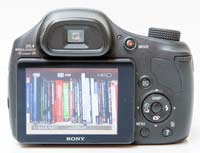 |
| Front | Rear |
We also get an AF assist/self time lamp porthole top left of the lens when viewing the camera front on. The barrel itself features a lens ring, which will hold real appeal for photographers who prefer to get hands on, as this not only controls the zoom - if you don't want to use the compact camera-style lever that alternatively encircles the shutter release button - but can also be used to focus if flicking the switch at the side of the lens to 'MF' mode.
The top plate of the camera extends the HX300's sophisticated look and feel, with a stereo microphone sitting just behind the otherwise hidden raised flash. To the right of this, when looking down at the camera as you grip it in both hands, is a small button for swapping between use of the EVF and LCD. Note that there's no longer an eye sensor on the HX300, unlike its predecessor, something that we sorely missed in practice.
The next control along is the narrow lozenge shaped on/off button, with an embedded lamp that glows green when the camera is switched on, or orange if the battery is low and the unit is being recharged. Incidentally we don't get a separate mains charger here. We get a mains lead, adapter and plug instead, meaning that the lithium ion pack is charged in-camera. When your battery is down, so is the camera therefore.
The Cyber-shot HX300 takes roughly two seconds to power up, lens extending a little beyond its protective housing to arrive at maximum wideangle setting while the image on the rear LCD pops into life. While slower than an actual DSLR, that's respectable enough for this class of bridge camera.
The camera is commendably swift to determine focus and exposure, with the green AF point/s highlighted on-screen the very instant your finger presses down on the shutter release button and finds the half way point. Press down fully to take the shot and a full resolution 20 megapixel JPEG is committed to removable media card in just over two seconds - so respectably swift. Face detection/selection and tracking focus are also offered here as standard features, activated or de-activated via a press of the unmarked button at the centre of the Sony's backplate command pad.
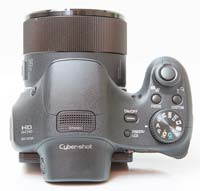 | 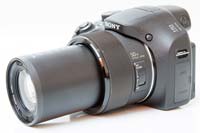 |
| Top | Side |
Keep a forefinger on the zoom lever that encircles the shutter release button and the HX300 powers through its 50x optical zoom range from wide angle to telephoto in around 4 seconds. The alternative method is to use the manual zoom ring as already mentioned, though this is slower to respond than using the zoom lever. However the upshot is that it's slightly easier to arrive at more precise framing.
Next to the power button is a raised, ridged-edged shooting mode button with an action that is stiff enough to prevent the user accidentally slipping from one setting to the next in the thick of it. There are 11 options on this dial. We get the creative quartet of program, shutter priority, aperture priority and manual mode settings plus Sony's now ubiquitous Sweep Panorama function, whereby the user pans through an arc as directed by the on-screen arrows - the resulting elongated shot automatically stitched together in camera. It's both very effective and very easy to use.
Next to this setting we get a memory recall mode, which, as the camera describes recalls registered settings and resumes shooting. This feels slightly superfluous as we found the camera didn't lose the previous settings when it was turned off and then switched back on again.
Also on the dial is a dedicated High Definition video mode for up to 1920x1080 pixels clips at 50 frames per second progressive capture, which complements the dedicated video record button top right of the backplate. While a press of the latter begins a recording despite the fact that you might have a stills shooting mode selected on the dial at the time, a press of the Menu button when in video mode and accesses a variety of options. Here we can not only adjust video resolution and vary the frame rate, but also switch from intelligent auto video recording to applying a specific scene mode, as we more usually can with stills photography. There's the ability to filter out external wind noise too, while another bonus is that full use of the optical zoom is provided in movie mode, as is automatic focus adjustment if you alter framing or swap subjects mid sequence.
This being a Sony camera we also expectedly find a 3D mode on the camera - with the ability to capture 3D stills or Sweep Panoramas as MPO files only viewable in the stereoscopic glory on a suitably equipped TV, or alternatively there is Sony's Sweep Multi Angle mode which provides a lenticular print type view on the camera's LCD screen, so at least you can get a 3D type effect in situ.
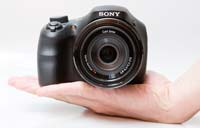 | 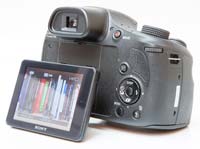 |
| Front | Tilting LCD Screen |
Scene modes are up next and there are 16 user selectable options on the HX300, covering everything from the usual portraits - including a separate DSLR-style 'background defocus' option - to shooting landscapes by night and even handheld; pet, beach, snow and fireworks mode round out the more usual suspects.
Rounding off the shooting mode options are both the scene and subject recognizing and thereby automatically adjusting Intelligent Auto mode, plus Superior Auto mode. The latter is, if you will, your in-camera version of Photoshop, adjusting images on the fly. This means that there is a little additional automatic processing happening in this mode, so it's slower to get an image from capture to card than when shooting in, say, Program mode. But it is a welcome aid in trickier conditions such as low light and does allow the user to point and shoot rather than having to find and change the ISO setting manually.
Incidentally the sensitivity range is broad and stretches from ISO to ISO12,800 with many incremental points in between. Our only moan is that we could have really done with a dedicated ISO button marked as such. There is a 'custom' button provided alongside the one for 'focus' just behind the shutter release on the top plate, but there's a choice of dedicating this to auto exposure lock (AEL), white balance, metering mode or switching on the smile shutter facility. With the shutter release button and the zoom lever that encircles it comfortably sloping forward at the top of the handgrip, that's it for the HX300's top plate.
The rear of the HX300 is dominated by the tilting 3-inch, 921k dot resolution LCD screen, which can be angled up or down, but not swung out through 180° so it sits alongside the body, like with a camcorder, or flips inward to face the body itself. This means that, whilst very useful in itself compared with a fixed monitor, it is best used for achieving those otherwise awkward low or high angle shots than anything more ambitious. The alternative as mentioned earlier is to use the EVF ranged directly above the LCD, though as this is both smaller and has a lower resolution (202k dots), we found it easy to overlook.
In terms of controls the back of the camera looks slightly sparse mainly due to the small dimensions of the actual buttons, though in fact most of the essentials are here. A dedicated movie button is located to the right of the viewfinder, while a DSLR-like jog dial sits alongside that, where it automatically falls under the thumb of the right hand as the camera is gripped. If you're shooting in Program mode a press of this allows access to the likes of ISO, shooting speed and aperture value on screen, though we had to press quite hard and repeatedly to arrive on the settings required - each highlighted in turn - at which point a spin of the same dial is required to make alterations. It works, but requires a period of familiarization, and is more fiddly than simply selecting ISO speeds from an on-screen menu or toolbar.
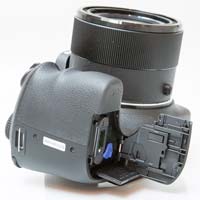 | 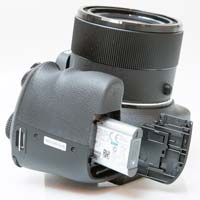 |
| Memory Card Slot | Battery Compartment |
Speaking of toolbars, beneath the movie record and playback buttons on the rear of the camera is one marked Menu, a press of which summons a toolbar. This appears ranged to the left hand side of the screen. It's here that we have access to the camera's set up folders and the in-camera help guide, even though a dedicated button marked with a question mark is additionally provided for such a purpose. Also on the toolbar is a means of saving chosen settings to the Memory Recall mode provided on the top plate shooting dial, choosing between two Steadyshot options when recording video ('standard' or the stronger 'Active'), fixing movie quality, deploying noise reduction, individually controlling sharpness, contrast and colour saturation (with 'standard' being the default setting), plus switching between the default 'standard' colour mode and vivid, 'real', sepia or black and white toned options.
In addition, the intensity of the flash can be dialed up or dialed down, the sensitivity of the 'smile shutter' feature can likewise be altered to register a slight up-turn of the mouth or alternatively a big goofy grin, or the automatic feature turned off entirely. Furthermore we get three exposure and one white balance bracketing options, continuous burst shooting of either 10fps per second for up to 10 sequential shots or 2fps to the same number, plus selection of metering modes (multi segment, centre weighted or spot). Still image size can of course also be adjusted via this same left-of-screen toolbar, with 20 megapixels in 4:3 aspect ratio being the top setting.
Lastly at the end of this exhaustive list we find a smattering of fun picture effect options. Here these comprise a painterly High Dynamic Range option, a chrome like rich-tone monochrome, the ubiquitous toy camera and miniature effects, pop art, soft high key, watercolour, and a funky illustration effect emphasizing subject outlines but smoothing the detail therein.
The familiar four-way control pad at the bottom right of the HX300's backplate features options for controlling the rear display, flash settings (with red eye reduction turned on or off via the menu screens), self timer (two or 10 seconds) plus, more unusually, bringing up some on-screen 'photo creativity' options if the user is shooting in one of the auto modes. Selecting this option on the pad, for example, allows users to darken or lighten the image by flicking the jog dial left or right. Colour can also be adjusted in the same manner and the picture effect options previously detailed can be flicked through via a virtual mode dial. It reminds us a lot of the Live Guide feature on Olympus Pen cameras; namely it allows newcomers to exert some personal control over the outcome of their shots without knowing anything about exposure values, aperture settings and so on, with adjustments shown on screen live and in real time before the shutter release button has even been pressed.
On either flank of the camera is a metal lug for attaching the provided shoulder strap, while on the left hand flank there is a flip-open door protecting the camera's two ports. Here we get an HDMI output and the new Multi Terminal Interface port which allows the connection of a growing range of accessories. Incidentally battery life of the lithium ion cell inserted in the base of the handgrip is around 300 shots, quite a big reduction on its predecessor's 450+ shot life. On the bottom of the HX300 is a metal screw thread located and a compartment housing the battery and a slot for either Memory Stick PRO Duo or Secure Digital cards.

 Cyber-shot DSC-HX300 Black Digital Camera (20.4 MP, 50x Opt, MS/SD Card Slot)
Cyber-shot DSC-HX300 Black Digital Camera (20.4 MP, 50x Opt, MS/SD Card Slot) 



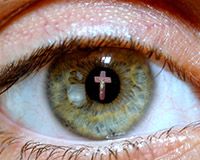






No comments:
Post a Comment